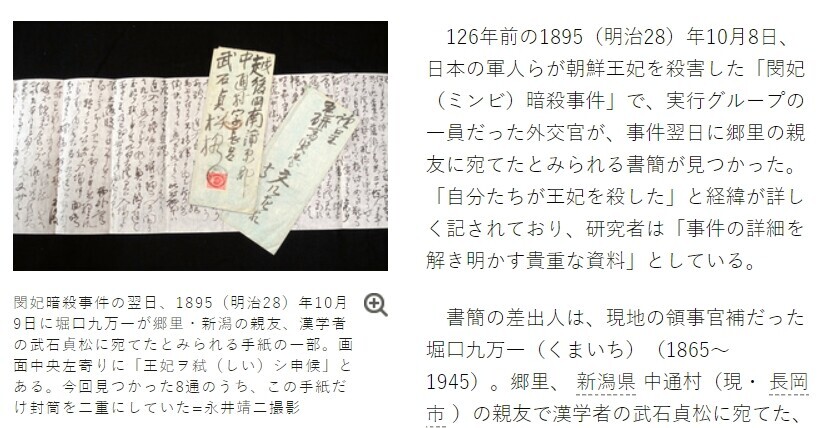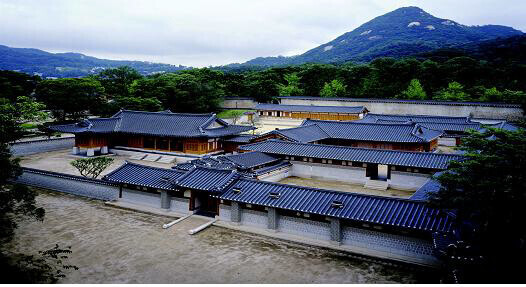hankyoreh
Links to other country sites 다른 나라 사이트 링크
Newly discovered letters show Japanese diplomat played part in assassination of Queen Min

In a newly discovered cache of letters written 126 years ago, a Japanese diplomat tells a friend that he’d taken part in killing Empress Myeongseong of Korea, also known as Queen Min. These rare documents show that Japanese diplomats in Korea were directly involved in the queen’s death.
Kumaichi Horiguchi (1865–1945), a consular assistant in Korea, provided a detailed description of the circumstances around Myeongseong’s assassination in a letter he sent to a friend in Japan the next day, on Oct. 9, 1895, Japanese newspaper the Asahi Shimbun reported on Tuesday.
“We killed the queen,” Horiguchi wrote in the letter.
“My job was securing entrance [to the palace]. We crossed the wall [. . .] and barely got into the building where we killed the queen,” he said.
Horiguchi also recorded his feelings about the assassination. “I was shocked to realize how easy it was.” He was among the group of diplomats, police and civilians who killed the queen.
The cache consists of eight letters that Horiguchi wrote between Nov. 17, 1894, and Oct. 18, 1895, soon after Myeongseong’s assassination. The letters were purchased at a flea market by a man named Steve Hasegawa, who lives in Nagoya. The letters’ flowing brushstrokes were deciphered by Kim Mun-ja, a Korean Japanese scholar and author of the book “Japanese and the Killing of the Korean Queen.”
“The [letters’] description of family and the details of the incident leaves no doubt that they were written by [Horiguchi] himself. It was quite shocking to read this diplomat write about being personally involved in killing a queen while serving in his post,” Kim told the Asahi Shimbun.

Myeongseong was assassinated on Oct. 8, 1895, during a raid on Gyeongbok Palace by Japanese police, soldiers, and other figures working to further Japanese expansion in East Asia, along with a few Koreans, including Woo Beom-seon (1857–1903), commander of the First Battalion of the Hullyeondae regiment — a regiment of soldiers trained under the Japanese. The assassination was carried out on the orders of Miura Goro (1847–1926), a veteran of the Japanese army and Japan’s minister to Korea. After killing the queen, they poured oil over her body and burned it.
A detailed account of the assassination was provided in a report by Kencho Suematsu (1855–1920), then director-general of the Cabinet Legislation Bureau, who noted that it was “truly unbearable” to put the events on paper.
In the past, it was thought that Japanese ronin (leaderless samurai) had played a leading role in killing Myeongseong, but more recent revelations have shown that Japanese in more official positions — including acting diplomats such as Horiguchi — also played an important role in carrying out the deed.
But even these records don’t state exactly who struck the killing blow. Sadatsuchi Uchida, who was then the first consul at the Japanese mission to Korea, said in a report to Vice Foreign Minister Takashi Hara that the queen had been stabbed by “a certain lieutenant in the army,” but several other figures have also been named.
Because of a clause about extraterritoriality in the unequal treaty that Korea and Japan signed in 1876, the Korean government was unable to try the Japanese who had taken part in assassinating the queen.
The assassins were taken to Japan for trial after the incident but ultimately faced no punishment. Eight officers in the Japanese army were acquitted in a military tribunal in Hiroshima the next January, while 48 others, including Horiguchi, were released after a Hiroshima district court dismissed the charges against them on the grounds of insufficient evidence. The unequal treaty remained in effect until Korea was forcibly annexed by Japan.
By Cho Ki-weon, Tokyo correspondent
Please direct questions or comments to [english@hani.co.kr]

Editorial・opinion
![[Column] Season 2 of special prosecutor probe may be coming to Korea soon [Column] Season 2 of special prosecutor probe may be coming to Korea soon](https://flexible.img.hani.co.kr/flexible/normal/500/300/imgdb/original/2024/0426/3317141030699447.jpg) [Column] Season 2 of special prosecutor probe may be coming to Korea soon
[Column] Season 2 of special prosecutor probe may be coming to Korea soon![[Column] Park Geun-hye déjà vu in Yoon Suk-yeol [Column] Park Geun-hye déjà vu in Yoon Suk-yeol](https://flexible.img.hani.co.kr/flexible/normal/500/300/imgdb/original/2024/0424/651713945113788.jpg) [Column] Park Geun-hye déjà vu in Yoon Suk-yeol
[Column] Park Geun-hye déjà vu in Yoon Suk-yeol- [Editorial] New weight of N. Korea’s nuclear threats makes dialogue all the more urgent
- [Guest essay] The real reason Korea’s new right wants to dub Rhee a founding father
- [Column] ‘Choson’: Is it time we start referring to N. Korea in its own terms?
- [Editorial] Japan’s rewriting of history with Korea has gone too far
- [Column] The president’s questionable capacity for dialogue
- [Column] Are chaebol firms just pizza pies for families to divvy up as they please?
- [Column] Has Korea, too, crossed the Rubicon on China?
- [Correspondent’s column] In Japan’s alliance with US, echoes of its past alliances with UK
Most viewed articles
- 1Samsung subcontractor worker commits suicide from work stress
- 2‘We must say no’: Seoul defense chief on Korean, USFK involvement in hypothetical Taiwan crisis
- 3[Editorial] Korea’s surprise Q1 growth requires objective assessment, not blind fanfare
- 4Division commander ordered troops to enter raging flood waters before Marine died, survivor says
- 5Is Japan about to snatch control of Line messenger from Korea’s Naver?
- 6No good, very bad game for Korea puts it out of Olympics for first time since 1988
- 7US overtakes China as Korea’s top export market, prompting trade sanction jitters
- 8N. Korean delegation’s trip to Iran shows how Pyongyang is leveraging ties with Moscow
- 9Korea’s 1.3% growth in Q1 signals ‘textbook’ return to growth, says government
- 10[Column] Season 2 of special prosecutor probe may be coming to Korea soon